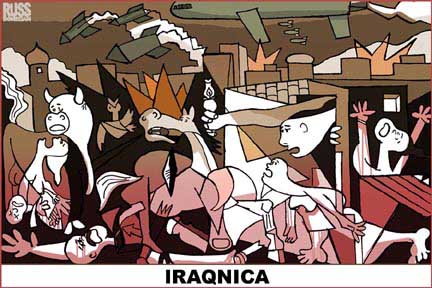This morning at about 4:30 am--I'd woken up by a family call from 12 time zones away--I bumped into a deeply disturbing Reuters' news report from Najaf (Michael Georgy, "U.S. Air Strikes Spread Fear in Najaf" August 20, 2004).
Reading Georgy's report made me wonder whether there is any noble feelings one may experience in confronting such carnage unleashed with technologically advanced weapons of (mass ?) destruction raining terror upon the population below. (For evidence of the carnage at its earlier stages, one can start with reports collected here.)
Although feelings of anger in cases similar to this one would be considered a natural reaction and the absence of such feelings an oddity (except perhaps in great historical human beings who were masters of their emotions), it still seems to me that anger cannot be noble or virtuous.
Anger (particularly when combined with fear) darkens the mind and clouds the eyes. It blunts positive social feelings and strenghtens the asocial ones.
On the other hand, it appears to me that a feeling of shame can be truly noble in cases such as this.
By "a feeling of shame" I do not mean "feeling ashamed of X" or "feeling ashamed of oneself" where X could be, say, one's facial or bodily features or some other similar aspect of one's existence for which one has little or no a priori responsibility. Instead, I use "shame" to refer to an emotion that may arise when something horrible is done in one's name or under one's watch or involving one's resources, an emotion that would be mixed with a deep sense of real and factual responsibility. (Of course, some degree of emotional education is required before one begins to experience such feelings. I've written earlier, very briefly, about the importance of such emotional education.)
By the way, Georgy's report ends in the following paragraph:
"You know the snipers shoot donkeys to intimidate us. The smell got to be so bad after 25 were killed that we collected them and put them in one grave just up the street," said Abdel Sanassi. "It's a warning."
Now, all this reminds me of Pablo Picasso's Guernica.
 |
|
 | Here's a creative take on Guernica which attempts to apply it, rather crudely, to the aerial bombardments in Iraq.
|

This comment has been removed by a blog administrator.
ReplyDelete